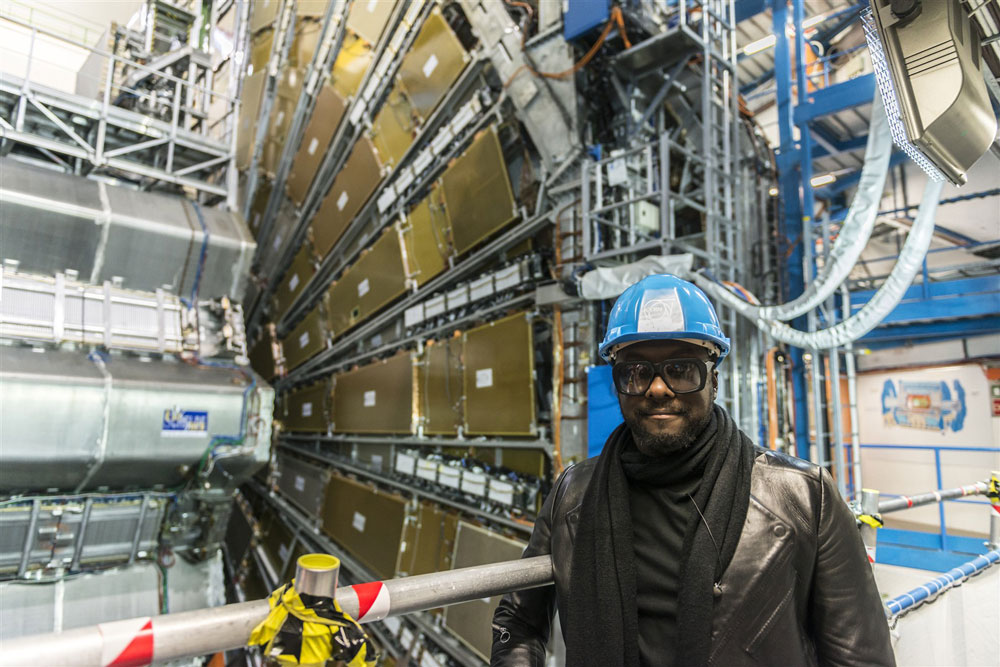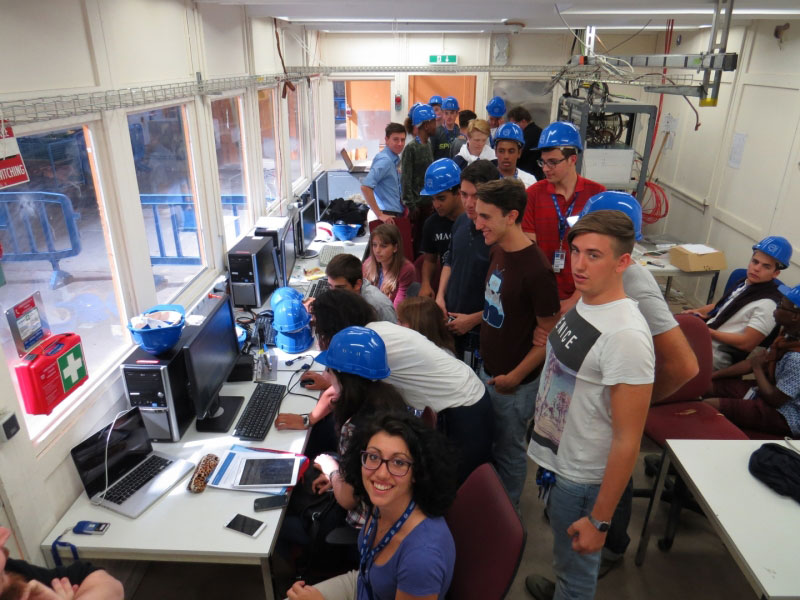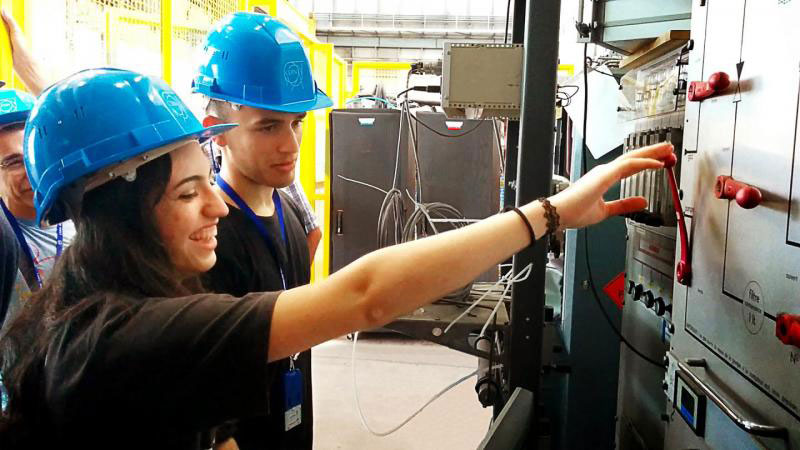CERN’s high-school physics competition shines bright Inspire article
Win the Beamline for Schools competition and take a trip to CERN to do your own real-life particle physics experiment.
Not many high-school competitions are endorsed by science-loving celebrities such as musician will.i.am and pop band The Script. But there’s something about CERN’s Beamline for Schools competition that gets people excited.
“I now have an idea what it must feel like to receive a phone call from Stockholm,” says Colleen Henning, a teacher at St John’s College from Johannesburg, South Africa, who led one of the winning teams at last year’s competition, likening the feeling to winning a Nobel prize. “Learning the news that we were joint winners of the CERN Beamline for Schools competition will be an experience I will always remember.”
Launched in late 2013 as part of CERN’s 60th birthday celebrations, the competition makes a fully equipped beamline available for high-school students to run an experiment by firing accelerated protons at a target – in the same way that researchers do at the Large Hadron Collider and other CERN facilities.
But the competition does more than just give students a chance to play on actual, functioning science equipment: it exposes a host of new students and teachers to particle physics and gives them the opportunity to be real scientists.

“Particle physics is in hardly any school curriculum around the world for this age, so the competition asks that teachers and teams spend a substantial amount of time with physics to make a meaningful proposal. For many students, this is their first contact with particle physics,” explains CERN’s Markus Joos, who currently manages the initiative.
“The competition is about all the teams participating; even those who aren’t shortlisted still learn about physics. Some of the proposals are not feasible, suggesting things that even professional physicists can’t manage. But while such a proposal might not win, it’s still a success as it brought that team to the point that they know what, say, a neutrino is, and they know that understanding its mass is important. Unsuccessful teams can always get in touch the following year and put together a more feasible proposal, building on their past knowledge.”
In the past three years, Beamline for Schools has received more than 570 proposals, representing more than 5000 high-school students who have been motivated to learn more about physics just so they can submit a proposal that stands a good chance of winning.
The competition’s effect on participants is clear from their proposals. The team 30(ns)toBang, which recently applied for the 2016 competition, wrote: “We have to know who we are, our strengths, our weaknesses, our limits and it is projects like Beamline for Schools that help us do precisely this. This project made us get out of our comfort zone, open our minds, it also made us realise how little we actually know and therefore, it made us curious to learn more about particle physics, a branch we know very little of even now.”
Shining bright
Last year, two teams shared the top prize. Colleen Henning’s team, Accelerating Africa, and Leo4G – a team of 19 students from Liceo Scientifico Leonardo da Vinci school in Florence, Italy.
“When I first heard the good news I was ecstatic, my hands were shaking and my heart was beating faster than usual,” says Malaika, a student from Barnato Park High School who was part of Accelerating Africa. “I’ve always wanted to pursue a career in physics or engineering and winning this amazing competition has brought me closer to my dreams. I’ve always wanted to travel abroad as I have never been overseas, nor have I been in an airplane. I’m truly thankful for this opportunity given to me and I know that I will take it with my two bare hands and not let go of it.”
Accelerating Africa wanted to use the CERN beamline to produce high-energy gamma rays with a crystalline undulator. The crystal they used was made from diamonds grown in a lab with the aid of De Beers – a benefit of the Beamline for Schools competition is that it allows high-flying academic students to come into contact with international companies.

Image courtesy of Markus Joos/CERN
Leo4G’s project was a very simple one that involved using and calibrating a particle detector built from a customised web-cam. To prepare their proposal, the team got in touch with their local physics research centre and visited a linear particle accelerator at the University of Florence.
The competition places a lot of emphasis on treating the students as scientists from the very beginning. Once the winning team is announced, they work with CERN physicists, technicians and staff to fine-tune their proposal for CERN’s equipment.
Physicists, engineers and experts in beams, detectors, data acquisition, data analysis, safety and radio protection from across all CERN departments are on-site to guide the students through the experiment, training them in the specifics of shift work and acquiring data. In 2014, detector physicists Cenk Yildiz and Saime Gurbuz spent weeks writing data-acquisition software and preparing the beamline to run the winning teams’ experiments.
“Even after the competition and their visit has ended, we encourage winning teams to write two documents: one, a journal of recording their experience for their local media, and two, a research paper, which we help them to publish,” says Markus. One of the 2014 winning teams took two years to write their paper, meaning a period in which they team stayed up-to-date on new findings from particle physics the whole time.
The kindness of teachers
“For a teacher to be able to guide their team, he or she will also have to understand the physics they will be using. We provide teachers with the documents to bring them up to a level that allows the students to make a meaningful proposal. We know it can be a big investment,” Markus says.
Time is also an important investment: drafting the proposals for the competition takes on average twenty hours of work, which can seem like a lot when students and teachers already have full days.
“From the very beginning I believed in the positive side effects that being involved in such an experience would have on my students and on me,” shares Manuela Lima, one of the teachers who led the winning Leo4G team. “It was a race against time because we really had very little time to prepare our project. We worked very hard, also outside of school hours, and everyone contributed by giving his and her best. I am certain that none of us will ever forget this fantastic event and achievement!”

This year, CERN is inviting applications earlier than in previous years, which Markus hopes will allow teachers to factor them into their syllabus plans. “The competition depends entirely on the motivation of the teachers,” he explains.
He urges future physicists and their teachers not to be daunted by the time commitment. “Any proposal is OK: it serves the purpose of educating. It shouldn’t be a case of not entering because ‘our idea won’t win’, firstly because there’s a second category of prizes for shortlisted teams, and also because even submitting a proposal is a success – you’ve gone through the whole process that a real scientist would go through.”
Resources
- Find out more about the Beamline for Schools competition and how to get involved on their website.
- To read more about this year’s Beamline for Schools competition see: (2016) Sign up your students to see the large and small. Science in School 37: 4.
- Learn more about CERN’s Large Hadron Collider, the world’s largest and most powerful particle accelerator.





